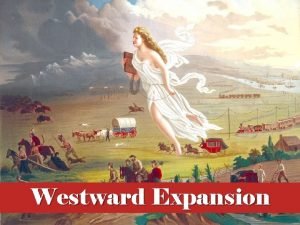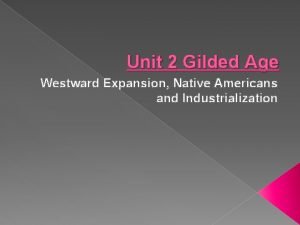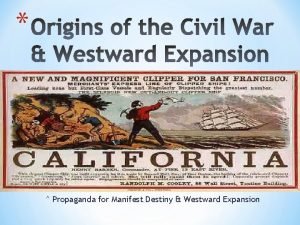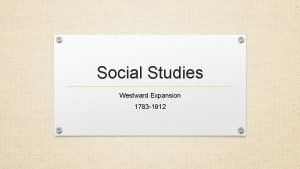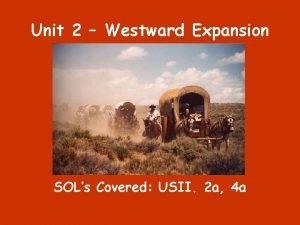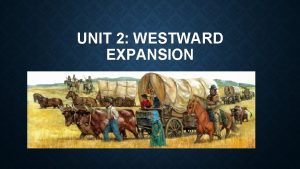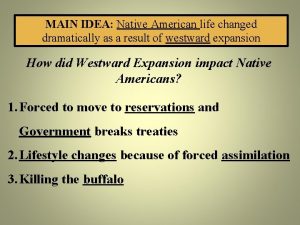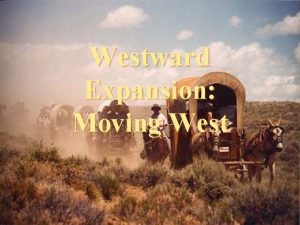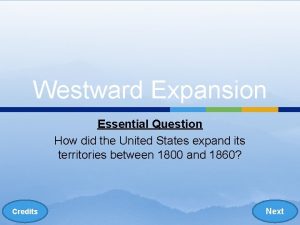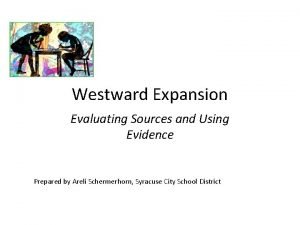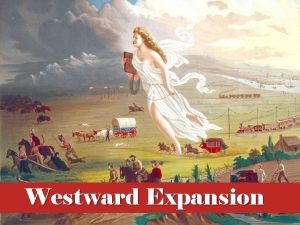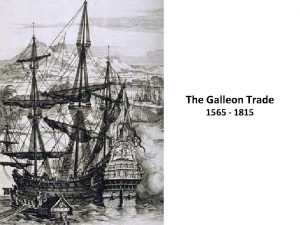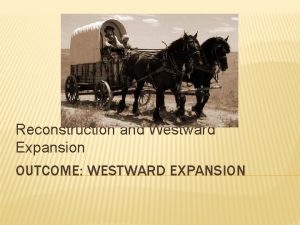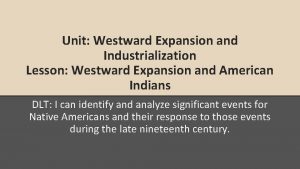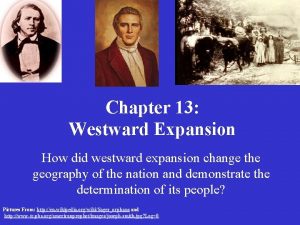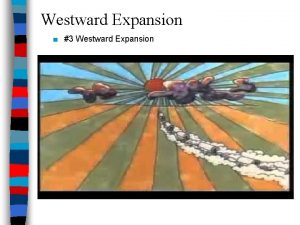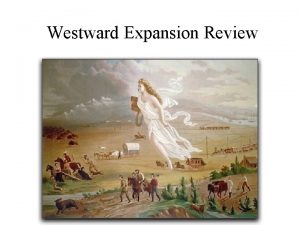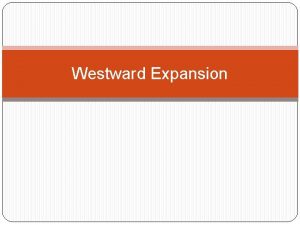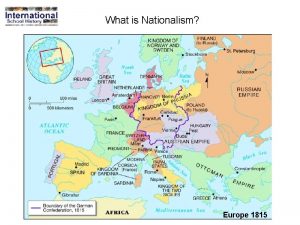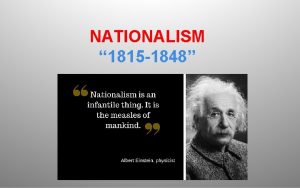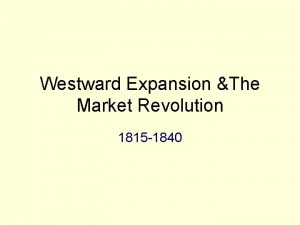NATIONALISM ECONOMIC EXPANSION AND WESTWARD EXPANSION 1815 1850
































- Slides: 32

NATIONALISM, ECONOMIC EXPANSION, AND WESTWARD EXPANSION 1815 -1850

Major Debates as the New Nation grows • 1. How do we pay for internal improvements? Should the federal government build roads and canals? • 2. Do we need a national banking system? • 3. Should tariffs be raised or lowered to promote economic development? • 4. How do we regulate and control westward settlement? • 5. How do we settle disputes and regulate interstate commerce? • 6. Who has the authority to deal with the Native Americans?

Expansion and Migration • After the War of 1812 there was a surge of American nationalism, pride, and nation building. • American perspective shifted from Europe to the American West after 1815

Reasons for Westward Expansion, 1812 -1840 • Population of U. S. almost doubled in 20 years and Americans were “pushed” westward to find new land • American economy was growing • New transportation systems emerged • Industrialization increased • Crops had depleted the soil along east coast, Americans were seeking new land • War of 1812 weakened the power and size of Native American tribes and Indian removal led to

• Federal government acquired land through treaties with tribes • Forts helped secure the region • Settlers flooded into the West and the population grew faster than any other region of the nation • Westward movement brought groups into contact and conflict with each other *** This rapid movement impacted the nation’s expanding economy, growing regional tensions, and political divisions that eventually led to Civil War

North: Early Industrialism • Rise in manufacturing after 1812 • Traditional methods but innovative financing through “putting out” system • “putting-out”--merchants deliver raw materials for farm families, artisans to complete the product • Textile industry led development of factory system in Lowell, Massachusetts and Americans began producing their own cloth • Northern states wanted high tariffs (taxes on imports) to protect American manufacturers. The Southern states wanted lower tariffs to promote international trade and cheap imports.

A Revolution in Transportation • After the War of 1812 political leaders recognized the need to improve the country’s transportation network to achieve their goals: national security economic progress political unity • Political Debate: Should the federal government help finance roads and other “internal improvements”?

Roads and Turnpikes • Federal money used to build a National Road from Cumberland, Maryland to Wheeling, Virginia improved trade and travel • Private turnpikes built by entrepreneurs • Roads useful but unprofitable


Steamboats • • Network of rivers encouraged economic development Flatboats transported down river early Steamboats transported upriver after 1811 Upriver capabilities reduced costs Steamboats soon carried more cargo on the MS River than all earlier forms of river transportation combined (flatboats, barges, etc) With steamboat traffic Congress to establishes safety regulations The first steamships crossed the Atlantic leading to an increase in international exchange of goods and people=global economy expands

River Systems


Robert Fulton, inventor, demonstrated the full potential of the steamboat (1811)

The Clermont

Steam Stats • In 1820 there were 31 steamboats operating on the MS River, 15 years later there were 361. • Before steam it cost $5 to move 100 pounds of freight by river from New Orleans to Louisville. In twenty years the price dropped to 25 cents.

Land Speculation and Westward Settlement • West settled to escape overpopulation, rising land prices, worn-out soil • Cooperation, strong community was necessary for survival • Land values rose rapidly in a few years • Rising prices encouraged settlers to sell out and move on, land speculation drove westward settlement

Settlement in the Mississippi River Valley: Indian Removal • Indian Removal policy begins after 1815 Contain them Civilize them Remove them Exterminate them • Some Indians retained tribal homelands

Settlement to the Mississippi: Settlers Move In n. By 1840 over 1/3 of U. S. population lived west of the Appalachians n. Speculators sold land parcels to settlers on credit=cycle of debt n. Settlers immediately engaged in commercial farming to pay off debt n. Access to markets gained by network of market towns, regional centers

The Beginning of Commercial Agriculture • Lower transportation costs mean greater income for the farmer • Sale to distant markets involves farmers in a complex system of credit • Market stimulates specialization in commercial farming • Ohio Valley produces wheat • Lower South produces cotton

Reasons the South became the World’s Leading Producer of Cotton • 1. Textile manufacturing in England drove demand for more cotton • 2. In 1793, Eli Whitney invented the cotton gin =cut labor costs, cheaper product • 3. Fertile land was available in the Southwest • 4. Slavery provided the needed labor force • 5. River systems provided easy transportation

Commerce and Banking • Commercial farming stimulated a new system of marketing • Farmers borrowed against future crops • Use of credit stimulated banking • State banks increased after 1812 • 1816 --Second Bank of the United States created to check state banks • Bank’s easy credit sparked the Panic of 1819=(Sound like today? )





Port of New Orleans: Exports • 1816=37, 000 bales • 1830=428, 000 bales • 1840=923, 000 bales • In the South production tripled from 1817 to 1840 ( 461, 000 bales to 1, 350, 000 bales)

The Canal Boom • Erie Canal was first transportation link between East and West, 1825 • Canal cut East-West transportation costs dramatically • Canal stimulated commercial growth of New York City and transformed the economy of the northeastern U. S.

Emergence of a Market Economy • Canals cut shipping expenses for western farmers and eastern manufacturers • Steamboats on the rivers also reduced shipping costs and stimulated commercial agriculture • The nation was rapidly developing an integrated national economic system

Erie Canal: 364 miles long, 40 feet wide, 84 locks, opened in 1825


Erie Canal: The Nation’s First Super Highway

Story of Us: Erie Canal http: //www. history. com/shows/america-thestory-of-us/videos/building-the-eriecanal#building-the-erie-canal
 Liberalism and nationalism in germany 1815-71
Liberalism and nationalism in germany 1815-71 Westward expansion lewis and clark
Westward expansion lewis and clark Unit 3 rev. statehood and westward expansion
Unit 3 rev. statehood and westward expansion Westward expansion discussion questions
Westward expansion discussion questions Westward expansion vocabulary
Westward expansion vocabulary Gilded age acrostic poem
Gilded age acrostic poem California gold rush advertisement
California gold rush advertisement A trip westward question and answer
A trip westward question and answer Westward expansion timeline
Westward expansion timeline American expansion westward/manifest destiny
American expansion westward/manifest destiny Who made
Who made Westward expansion wagon
Westward expansion wagon Homeland security
Homeland security Westward expansion vocabulary
Westward expansion vocabulary Unit 2 westward expansion vocabulary
Unit 2 westward expansion vocabulary Us territorial acquisitions map
Us territorial acquisitions map Assimilation westward expansion
Assimilation westward expansion Great plains westward expansion
Great plains westward expansion Westward expansion thesis statement
Westward expansion thesis statement Westward expansion clip art
Westward expansion clip art Westward expansion territories map
Westward expansion territories map Westward expansion
Westward expansion Westward expansion essential questions
Westward expansion essential questions Gained voter support by helping immigrants find jobs.
Gained voter support by helping immigrants find jobs. The oregon trail
The oregon trail Chapter 12 territorial and economic expansion
Chapter 12 territorial and economic expansion Territorial and economic expansion
Territorial and economic expansion What is economic growth and development
What is economic growth and development Ottoman empire 1750
Ottoman empire 1750 Effects of galleon trade in the philippines
Effects of galleon trade in the philippines Congresul de la viena 1815
Congresul de la viena 1815 Treaty of vienna 1815
Treaty of vienna 1815 Egzaminatorius kodai
Egzaminatorius kodai



